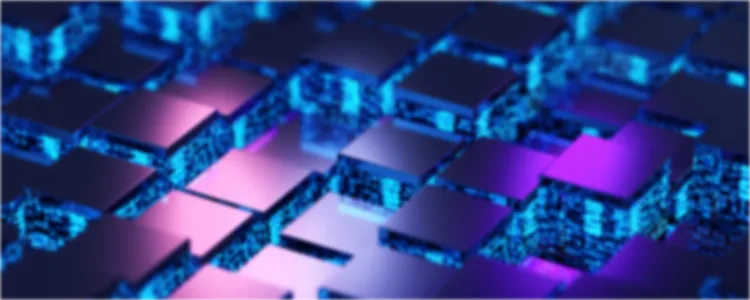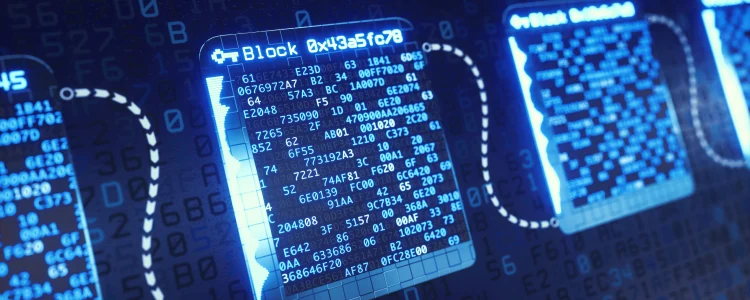Blockchain Infrastructure and Hardware Requirements Explained

All complicated systems need the right resources, framework, or infrastructure to function accurately. Enterprise blockchain infrastructure is no exception. Consequently, a blockchain proof of stake network needs nodes, software implementations, and cloud or hardware-based systems to function.
Blockchain infrastructure platform-as-a-service (PaaS) providers manage and control access to the basic infrastructure required to run their systems, such as cloud storage and data security, as well as the infrastructure that supports blockchains, such as dev tools and nodes. Let’s dive into the blockchain infrastructure and its security measures.

What is Blockchain Technology?
As discussed in a previous article on Blockchain, Blockchain technology is a framework for storing transactional data (sometimes called “blocks”) across multiple databases in a network connected by peer-to-peer nodes. This type of storage is frequently referred to as a “digital ledger.”
A blockchain is a distributed ledger that duplicates and distributes transactions among the network of computers involved in the blockchain. Blockchain is a method of storing data that makes it extremely difficult or impossible for the network to be altered, hijacked, or otherwise corrupted.

What is Blockchain Infrastructure?
The foundation of a blockchain is its infrastructure. Blockchain infrastructure is the tools or facilities that help blockchain technology work effectively. Blockchain is more than mere computer code; it is a combination of both hardware and software. Blockchain infrastructures are components or systems that support and facilitate the operation of blockchain technology. Operating a node round-the-clock is more important than the system requirements for blockchain development.
To pilot your blockchain initiatives appropriately, you must have plans for your infrastructure resources to sustain the original pilots and establish the groundwork for scaling up if and when those pilots go live. Because of this, you should consider how blockchain will affect your data center infrastructure and the business consequences of your emerging blockchain trials.

How to Build a Blockchain Infrastructure
If you plan to build a blockchain infrastructure, you should take the following steps to help you through the process.
Step 1: Identify an Ideal Use-case
The first step to building blockchain infrastructure is to identify a use case that makes it commercially viable. To find a use case that makes business sense, you should consider three things the blockchain can do well. These include:
- Data Authentication and Verification: This includes digital signatures, encryption, and immutable storage. The blockchain can store data in practically any format. Blockchains can be used to generate public-private key pairs and validate digital signatures.
- Smart Asset Management: This includes issuance, payment, exchange, escrow, and retirement transactions. A smart/crypto asset is the tokenized form of a physical asset, such as gold, silver, oil, or real estate.
- Smart Contracts: This includes digital voting systems, changing debate times, removing members, tweaking the voting rules. Smart contracts are stored on a blockchain and can run a response based on agreement with other blockchain participants.
Step 2: Identify the Best Consensus Mechanism
There are different consensus mechanisms you can use when building blockchain technology. For instance, bitcoin crypto-currency uses proof of work as a consensus mechanism. Other consensus mechanisms you can employ include proof of stake, Byzantine fault-tolerance, Deposit based consensus, Federated Byzantine Agreements, Proof of Elapsed Time, Derived PBFT, Redundant Byzantine Fault Tolerance, Simplified Byzantine Fault Tolerance, Federated consensus, Round-Robin and Delegated Proof of Stake.
However, you must select the consensus mechanism that is the most suitable for your use case.
Step 3: Identify the Most Suitable Platform
Blockchain platforms are widely available, most of which are open-source and free. The best blockchain platform should be chosen based on the consensus mechanism you decided on in step 2. Some of the most well-known blockchain platforms include Corda, Ethereum, EOS, Klaytn, Credits, Stellar, Quorum, Tron, XDC Network, Tezos, etc.
Step 4: Designing the Nodes
Private blockchains or Blockchain solutions can be permissioned or permission-less, while blockchain solutions can be private, public, or hybrid. It would be best to consider the nodes’ operating environment, whether cloud, on-premise, or both. Another factor to consider is the hardware configuration, like processors, memory, and disk size. Lastly, you need to choose base operating systems, which may be Ubuntu, CentOS, Debian, Fedora, Red Hat, or Windows.
Step 5: Design the Blockchain Instance
The components of the blockchain platforms require very carefully designed configuration. This includes permission, asset issuance, asset re-issuance, atomic exchange, multi-signature, key management, parameters, native asset, address format, key format, block signature, and hand-shaking.
This is an extremely important stage because some parameters can be altered at run-time while others cannot.
Step 6: Building the APIs
Blockchain platforms vary in their availability of ready-made APIs. However, you will need the following main types of APIs:
- Generating key pairs and addresses
- Performing audit-related functions
- Data authentication through digital signatures and hashes
- Data storage and retrieval
- Smart-asset lifecycle management –issuance, payment, exchange, escrow, and retirement
- Smart contracts
Step 7: Design the Admin and User Interface
This is the stage where you have to decide on the type of front-end and programming languages to use, which may include; HTML5, CSS, PHP, C#, Java, Javascript, Python, Ruby, etc. It would help if you also chose external databases and servers.
Step 8: Adding Future Tech
Integrating AI, Biometrics, Bots, Cloud, Cognitive services, Containers, Data Analytics, the Internet of Things, and Machine Learning will significantly boost the capabilities of your Blockchain solution.

Blockchain Infrastructure Requirements
New kinds of databases or software are only one aspect of blockchain technology. It is, therefore, necessary to have a complex and comprehensive infrastructure. The following are the software and hardware requirements for blockchain infrastructure.
Software Requirements for Blockchain
The software requirements include the following:
- Solidity
Solidity is one of the common languages used by Blockchain Developers. It was created to serve the Ethereum Virtual Machine and was shaped by C++, Python, and JavaScript. Solidarity is the most popular CIS and OOP framework for creating smart contracts. Blockchain developers can build an application that performs self-enforcing business logic in smart contracts using Solidity, maintaining a reliable and accurate record of all transactions. This is beneficial when designing contracts for voting, crowdsourcing, multi-signature wallets, and blind auctions.
- Geth
The Go programming language created the Ethereum node implementation known as Geth. It is accessible through three interfaces: a JSON-RPC server, a command line, and an interactive console. Geth is used for a wide range of operations, including token transfers, ether mining, the creation of smart contracts, and block history exploration. After installing Geth, you can connect to an existing Blockchain or build your own. The best part is that Geth makes things easier by establishing a connection to the Ethereum main net instantly.
- Mist
Mist is the official Ethereum wallet developed by Ethereum developers. It works with Windows (32- and 64-bit), Mac, and Linux (32- and 64-bit). Mist is exceptionally well suited to establishing smart contracts, but keep in mind that it is a full node wallet, requiring you to download the complete Ethereum blockchain, which is more than 1TB. Memorizing your Mist password is also important because it is a one-time setup requirement and cannot be changed.
- Solc
Solc (Solidity Compiler) is a C++-based Solidity command-line compiler. Its main objective is to translate Solidity scripts into an easier-to-understand version for the Ethereum Virtual Machine. Although, Solidity is a condensed, loosely typed programming language with syntax comparable to JavaScript, the smart contracts written in Solidity must be translated into a format that the EVM can readily understand and interpret. This is why Solc is useful. There are two types of Solc: the original Solc (written in C++) and the newer Solc-js (which uses Emscripten to cross-compile the original Solc source code from C++ to JavaScript). Solc can also be used for offline compilation.
- Remix
Remix IDE is a browser-based Blockchain tool for creating and deploying smart contracts. A remix is a tool for designing, testing, debugging, and deploying solidity-based smart contracts written in Javascript and accessible through any modern web browser. Remix has great documentation and can easily connect to the Ethereum blockchain via Metamask. However, other software requirements for blockchain infrastructure include blockchain test net, ganache, Blockchain-as-a-Service (BaaS), Metamask (wallet), and Truffle.
Blockchain Hardware Requirements
Blockchain computing hardware is generally referred to as high-performance computers or HPCs. These powerful computers are important to businesses because they enable tasks to be completed quickly and error-free.
These specifications and requirements may include processing speed, memory, storage, plug-ins, and environmental constraints such as shock, vibration, temperature fluctuations, and humidity levels.
- Central Processing Unit
The CPU or processor is the main component of a system. It is the brain of a computer system. It carries out complex operations that control the entire computer. Improved CPU performance translates into quicker work completion as it increases performance. However, blockchain technology is revolutionizing how we perceive computing power, particularly latency and real-time transactions.
- Blockchain and GPUs
Graphics cards are also referred to as graphics processing units. A GPU is designed to handle a computer’s display tasks, such as video rendering.
A GPU is made to perform several calculations per second with one important restriction: the calculations must not be very complicated. As a result, a CPU uses the GPU to handle specific processes, allowing it to concentrate on other essential measures that a GPU cannot handle.
- Nodes and Clients
A node is a computer that performs the essential tasks of the network, such as authenticating transactions, maintaining blockchain records, storing blockchain data, or casting votes for network governance. A client is a computer program that specifies how these important tasks should be carried out.
Depending on how the network is designed, it can support multiple software implementations or clients. Many computer languages can be used to build clients and can be implemented differently. There are different proof-of-stake network nodes: participation nodes, sentry nodes, replay nodes and read/write nodes.
- Clusters
A cluster is a set of network-specific nodes and their supporting infrastructure. A cluster consists of failover protection, load balancers, container services, and monitoring and alerting services. Two primary use cases include maintaining multiple clusters and supporting Blockchain client APIs.
See also: What is a Server Cluster?
Blockchain Security Infrastructure
Aside from the hardware and software requirements, the underlying blockchain infrastructure also includes vitals management, networking firewalls, audits, and other technical security considerations.
Security maintenance is done by distributing patches and updates to the code implementations sustaining a user’s blockchain infrastructure. Users can be protected from any risks, when detected, by staying up to date with the most recent patches and releases. Engaging in proof-of-stake blockchain networks requires significant technical know-how, time, resources, and robust underlying technology. The security infrastructures on blockchain networks include:
- Infrastructure as a Service (IaaS)
Blockchain infrastructure providers (IaaS) provide and offer direct infrastructure access to their customers, which includes running data centers, constructing security mechanisms, and managing servers.
- Platform as a Service (PaaS)
A blockchain infrastructure platform-as-a-service (PaaS) provider manages and retains access to those features while designing the code, the framework to access them, development tools, metrics and analytics, container services, and community support. This provides an easy method for deploying and maintaining the infrastructure that powers blockchains and the underlying infrastructure required to run their systems.
Customers can operate secure infrastructure on several blockchains with the help of a PaaS provider, saving them the time and expense of developing the necessary technical abilities. This helps to bridge the gap between token holders and developers on a decentralized network.
- Optimize Participation: Hardware, Nodes, and Solutions
A blockchain infrastructure PaaS provider allows users to access a blockchain network with-network signing. PaaS engineers program blockchain infrastructure based on customer needs to save time and resources required to build their infrastructure.
This includes executing custom custody requirements, pool fees, delegation rates, and custom cluster structures, such as the number of relay nodes connected to each validator node. Being a blockchain infrastructure PaaS provider also entails developing API solutions to help customers integrate blockchain resources into their existing products and services.
- Enterprise-Grade Security and Technical Support
A blockchain infrastructure PaaS provider maintains and monitors the nodes and their underlying infrastructure’s functionality. Clients’ clusters are monitored continuously with a spiraling flow of available engineers and devoted customer care professionals. Also, a blockchain infrastructure PaaS provider sends updates and patches to the code implementations sustaining a user’s blockchain infrastructure.
Patches and updates are promptly applied to guarantee that clusters are always running on the latest version, and the updates are carried out in a way that ensures the node has the lowest amount of downtime.
Conclusion
Blockchain infrastructures are components or systems that support and facilitate the operation of blockchain technology. However, blockchain infrastructures, that is, hardware and software, are critical to businesses that use enterprise blockchain technology. ServerMania is a server hosting company that offers customizable server clusters, hybrid, cloud, and dedicated servers, which you may need when building your blockchain infrastructure. We provide high-performance servers that are well-tailored to meet your needs. Contact ServerMania today and transform your server hosting experience.
Was this page helpful?

